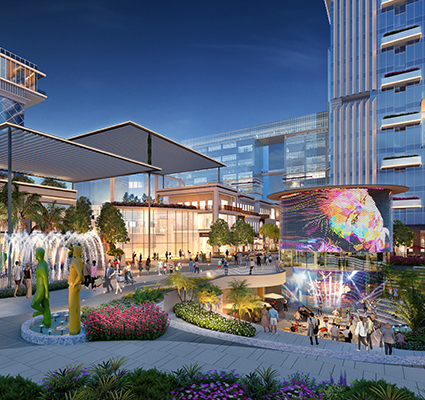2025 and Beyond: How Retail Spaces Are Evolving?
Table of Contents
- Introduction: Retail’s Changing Landscape
- What Is Experiential Retail? Why Is It the Future?
- Retail Spaces Are Becoming Lifestyle Destinations
- Technology Is Subtle, Yet Powerful
- Design Is Driven by Purpose, Not Just Looks
- Community and Connection Matter More Than Ever
- Flexibility and Adaptability Are Key
- Conclusion: Looking Ahead: The Rise of Future-Ready Developments
Retail spaces are evolving beyond just being places to buy products. They are now spaces where people come together, relax, and engage in meaningful experiences. Now the focus is shifting from transactions to creating memorable moments.
This shift in focus has given rise to experiential retail- A new trend thats turning shopping into something much more exciting and meaningful!
So, What Is Experiential Retail? Why Is It the Future?
Experiential retail is all about creating memorable, multi-sensory experiences in a physical retail environment.
Now, shopping isnt just about buying products; its about experiencing an interactive journey, creating moments that resonate with customers and leave lasting impressions. Instead of walking in, picking up a product, and walking out, customers are now invited to:
-
Interact with the brand
-
Engage with the space
-
Enjoy moments that go beyond the purchase
Let’s dive into how retail is being reimagined in this new era.
1. Retail Spaces Are Becoming Lifestyle Destinations
The traditional walk in, shop, and leave model is being replaced by a more immersive experience in retail space. These kinds of spaces turn shopping into an experience— where people want to stay longer, explore more, and return often.
Store layouts and designs are making the customers journey seamless and enjoyable. Instead of overwhelming shelves and confusing directions, youll find open, welcoming spaces that naturally guide you through.
Some key layout trends include:
-
Zoned areas for different moods and product typeslike cosy corners for reading or sleek tech zones for gadgets
-
Wide walkways that reduce crowding and let people explore at their own pace
-
Rest areas with benches, calming lighting, or greenery where shoppers can take a break
-
Clear signage and visual cues that guide without being pushy
-
Iconic stores that give an out of the world experience
These smart layouts arent just about looking good theyre about reducing stress and increasing comfort, especially in high-footfall areas like malls or flagship stores.
2. Technology Is Subtle, Yet Powerful
Technology has become an invisible partner in the retail journey. In 2025, its not about flashy screens its about using tech in ways that genuinely help customers.
All of this happens quietly in the background, enhancing the experience without overwhelming it. Retail tech is moving from show-off mode to service mode, which is exactly what customers want.
3. Design Is Driven by Purpose, Not Just Looks
The look and feel of retail spaces is becoming more meaningful. Instead of focusing only on glitz and glamour, retailers are using design to create a sense of belonging, calm, and identity.
Heres how thats showing up:
-
Use of natural materials that connect with sustainability
-
Biophilic design, which brings in nature through plants, indoor gardens, or earthy tones, to soothe the senses
-
Storytelling corners or immersive displays that help people understand the story behind a product
-
Lighting that changes with time of day to create moodscool and fresh in the morning, warm and relaxed in the evening
-
Restrooms to take good care of mother and child
These elements make retail spaces feel more human, less transactional, and more emotionally engaging.
4. Community and Connection Matter More Than Ever
In 2025, retail is becoming a space where people gather and connect, not just shop. People want meaningful social experiences, and the best retail spaces are becoming community hubs that offer exactly that.
Expect to see:
- Live music nights, art exhibitions, or cultural pop-ups in retail plazas
- Book readings, cooking demos, or product workshops in store lounges
- Co-working zones or Wi-Fi cafs inside the retail hubs
- Wellness integrations like yoga zones, spa pods, or mental health kiosks
- Alfresco dinning to spend time with your family and friends
These features turn a visit to the store into a multi-purpose outingshop, eat, relax, learn, or just unwind. Retailers that foster community will win lasting customer loyalty.
5. Flexibility and Adaptability Are Key
If the pandemic taught the retail world anything, its this— adaptability is survival. Retail spaces of 2025 are built to transform quickly based on trends, seasons, or customer needs.
Examples of this shift include:
-
Modular interiors where walls, shelves, and displays can be rearranged with minimal effort
-
Retail-café-art spaces that function differently depending on the time of day or event
-
Event-ready zones that can host everything from a fashion show to a community meetup
This flexibility allows businesses to stay relevant and fresh while also giving customers new reasons to come back.
Looking Ahead: The Rise of Future-Ready Developments
The future of retail is no longer just about sales— Its about stories, spaces, and shared moments!
Commercial real estate developers are embracing a new trend, “Experience-first Retail across India. This shift focuses on creating spaces that go beyond shopping. These spaces offer immersive, engaging experiences.
Project like The Flagship by CRC Group is leading the way in this innovative approach. They blend retail, leisure, wellness, and community experiences into a single unified destination. The project is perfectly designed to meet the needs of 2025 and beyond.
Step into the future of retail with destinations that offer more than just shopping, where experiences come to life. Discover the next evolution today!









